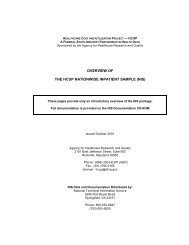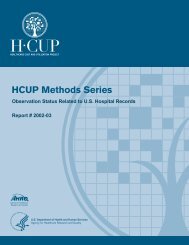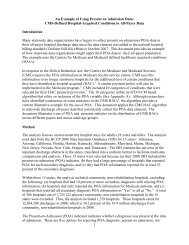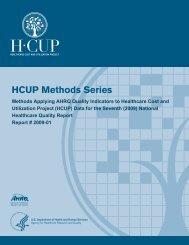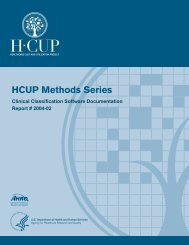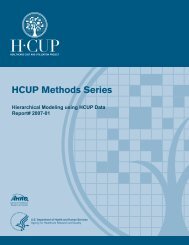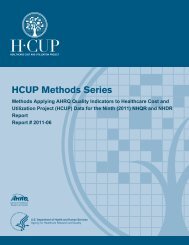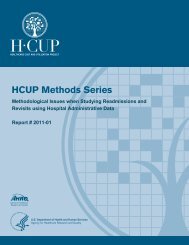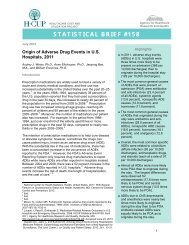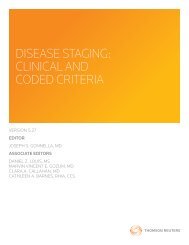Introduction to the HCUP Nationwide Inpatient Sample (NIS)
Introduction to the HCUP Nationwide Inpatient Sample (NIS)
Introduction to the HCUP Nationwide Inpatient Sample (NIS)
You also want an ePaper? Increase the reach of your titles
YUMPU automatically turns print PDFs into web optimized ePapers that Google loves.
were on <strong>the</strong> original records (NDX and NPR). See <strong>the</strong> notes on diagnoses (http://www.hcupus.ahrq.gov/db/vars/dxn/nisnote.jsp)<br />
and procedures (http://www.hcupus.ahrq.gov/db/vars/_prn/nisnote.jsp)<br />
on <strong>the</strong> <strong>HCUP</strong>-US Web site <strong>to</strong> view <strong>the</strong> number of<br />
diagnosis and procedure fields provided by each state.<br />
• The collection and reporting of external cause of injury (E codes) varies greatly across<br />
States. Some States have laws or mandates for <strong>the</strong> collection of E codes; o<strong>the</strong>rs do not.<br />
Some States do not require hospitals <strong>to</strong> report E codes in <strong>the</strong> range E870-E879 -<br />
“misadventures <strong>to</strong> patients during surgical and medical care” - which means that <strong>the</strong>se<br />
occurrences will be underreported. Be sure <strong>to</strong> read <strong>the</strong> State-specific notes on diagnoses for<br />
more details; this information can be found on <strong>the</strong> Description of Data Elements page on <strong>the</strong><br />
<strong>HCUP</strong>-US Website (http://www.hcup-us.ahrq.gov/db/nation/nis/nisdde.jsp).<br />
Missing Values<br />
Missing data values can compromise <strong>the</strong> quality of estimates. If <strong>the</strong> outcome for discharges with<br />
missing values is different from <strong>the</strong> outcome for discharges with valid values, <strong>the</strong>n sample<br />
estimates for that outcome will be biased and inaccurately represent <strong>the</strong> discharge population.<br />
For example, race is missing on 15% of discharges in <strong>the</strong> 2009 <strong>NIS</strong> because some hospitals<br />
and <strong>HCUP</strong> State Partners do not supply it. (The percentage of missing race values was higher<br />
in previous years.) Therefore race-specific estimates may be biased. This is especially true for<br />
estimates of discharge <strong>to</strong>tals by race. Ano<strong>the</strong>r set of data elements that are missing are hospital<br />
identifiers, which allow you <strong>to</strong> link <strong>to</strong> o<strong>the</strong>r datasets with <strong>the</strong> AHA hospital identifier. In 2009,<br />
about 43% of hospitals were missing specific identifiers.<br />
There are several techniques available <strong>to</strong> help overcome this bias. One strategy is <strong>to</strong> use<br />
imputation <strong>to</strong> replace missing values with acceptable values. Ano<strong>the</strong>r strategy is <strong>to</strong> use sample<br />
weight adjustments <strong>to</strong> compensate for missing values. 1 Descriptions of such data preparation<br />
and adjustment are outside <strong>the</strong> scope of this report; however, it is recommended that<br />
researchers evaluate and adjust for missing data, if necessary.<br />
On <strong>the</strong> o<strong>the</strong>r hand, if <strong>the</strong> cases with and without missing values are assumed <strong>to</strong> be similar with<br />
respect <strong>to</strong> <strong>the</strong>ir outcomes, no adjustment may be necessary for estimates of means and rates.<br />
This is because <strong>the</strong> non-missing cases would be representative of <strong>the</strong> missing cases. However,<br />
some adjustment may still be necessary for <strong>the</strong> estimates of <strong>to</strong>tals. Sums of data elements<br />
(such as aggregate charges) containing missing values would be incomplete because cases<br />
with missing values would be omitted from <strong>the</strong> calculations.<br />
Variance Calculations<br />
It may be important for researchers <strong>to</strong> calculate a measure of precision for some estimates<br />
based on <strong>the</strong> <strong>NIS</strong> sample data. Variance estimates must take in<strong>to</strong> account both <strong>the</strong> sampling<br />
design and <strong>the</strong> form of <strong>the</strong> statistic. The sampling design consisted of a stratified, single-stage<br />
cluster sample. A stratified random sample of hospitals (clusters) was drawn and <strong>the</strong>n all<br />
discharges were included from each selected hospital. To accurately calculate variances<br />
from <strong>the</strong> <strong>NIS</strong>, you must use appropriate statistical software and techniques. For details,<br />
see <strong>the</strong> special report, Calculating <strong>Nationwide</strong> <strong>Inpatient</strong> <strong>Sample</strong> Variances. This report is<br />
available on <strong>the</strong> <strong>HCUP</strong>-US Website at<br />
http://www.hcup-us.ahrq.gov/db/nation/nis/nisrelatedreports.jsp.<br />
If hospitals inside <strong>the</strong> frame are similar <strong>to</strong> hospitals outside <strong>the</strong> frame, <strong>the</strong> sample hospitals can<br />
<strong>HCUP</strong> <strong>NIS</strong> (09/06/2011) 15 <strong>Introduction</strong>



